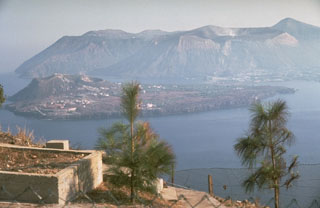Report on Vulcano (Italy) — February 1988
Scientific Event Alert Network Bulletin, vol. 13, no. 2 (February 1988)
Managing Editor: Lindsay McClelland.
Vulcano (Italy) New fracture system
Please cite this report as:
Global Volcanism Program, 1988. Report on Vulcano (Italy) (McClelland, L., ed.). Scientific Event Alert Network Bulletin, 13:2. Smithsonian Institution. https://doi.org/10.5479/si.GVP.SEAN198802-211050
Vulcano
Italy
38.404°N, 14.962°E; summit elev. 500 m
All times are local (unless otherwise noted)
"After the last explosive event, in 1888-90, activity has been mainly fumarolic emissions of varying intensity at the crater. A new fracture system, transverse to the main alignment along which the more recent activity had originated, opened during the last few months.
"No important seismic activity was detected at the same time, and the progressive spreading trend beginning in 1985 was not substantially modified. The rate of longitudinal opening (some meters/month), however, along with the well-defined magmatic character of the gaseous species emitted through these fractures, appear as a clear indication of an increasing pressure from beneath."
Geological Summary. The word volcano is derived from Vulcano stratovolcano in Italy's Aeolian Islands. Vulcano was constructed during six stages over the past 136,000 years. Two overlapping calderas, the 2.5-km-wide Caldera del Piano on the SE and the 4-km-wide Caldera della Fossa on the NW, were formed at about 100,000 and 24,000-15,000 years ago, respectively, and volcanism has migrated north over time. La Fossa cone, active throughout the Holocene and the location of most historical eruptions, occupies the 3-km-wide Caldera della Fossa at the NW end of the elongated 3 x 7 km island. The Vulcanello lava platform is a low, roughly circular peninsula on the northern tip of Vulcano that was formed as an island beginning more than 2,000 years ago and was connected to the main island in about 1550 CE. Vulcanello is capped by three pyroclastic cones and was active intermittently until the 16th century. Explosive activity took place at the Fossa cone from 1898 to 1900.
Information Contacts: M. Martini, Univ di Firenze.

